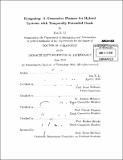| dc.contributor.advisor | Brian Williams. | en_US |
| dc.contributor.author | Li, Hui C., Ph. D. Massachusetts Institute of Technology | en_US |
| dc.contributor.other | Massachusetts Institute of Technology. Dept. of Aeronautics and Astronautics. | en_US |
| dc.date.accessioned | 2010-10-29T18:05:14Z | |
| dc.date.available | 2010-10-29T18:05:14Z | |
| dc.date.copyright | 2010 | en_US |
| dc.date.issued | 2010 | en_US |
| dc.identifier.uri | http://hdl.handle.net/1721.1/59661 | |
| dc.description | Thesis (Ph. D.)--Massachusetts Institute of Technology, Dept. of Aeronautics and Astronautics, 2010. | en_US |
| dc.description | Cataloged from PDF version of thesis. | en_US |
| dc.description | Includes bibliographical references (p. 230-237). | en_US |
| dc.description.abstract | Most unmanned missions in space and undersea are commanded by a "script" that specifies a sequence of discrete commands and continuous actions. Currently such scripts are mostly hand-generated by human operators. This introduces inefficiency, puts a significant cognitive burden on the engineers, and prevents re-planning in response to environment disturbances or plan execution failure. For discrete systems, the field of autonomy has elevated the level of commanding by developing goal-directed systems, to which human operators specify a series of temporally extended goals to be accomplished, and the goal-directed systems automatically output the correct, executable command sequences. Increasingly, the control of autonomous systems involves performing actions with a mix of discrete and continuous effects. For example, a typical autonomous underwater vehicle (AUV) mission involves discrete actions, like get GPS and take sample, and continuous actions, like descend and ascend, which are influenced by the dynamical model of the vehicle. A hybrid planner generates a sequence of discrete and continuous actions that achieve the mission goals. In this thesis, I present a novel approach to solve the generative planning problem for temporally extended goals for hybrid systems, involving both continuous and discrete actions. The planner, Kongming, incorporates two innovations. First, it employs a compact representation of all hybrid plans, called a Hybrid Flow Graph, which combines the strengths of a Planning Graph for discrete actions and Flow Tubes for continuous actions. Second, it engages novel reformulation schemes to handle temporally flexible actions and temporally extended goals. I have successfully demonstrated controlling an AUV in the Atlantic ocean using mission scripts solely generated by Kongming. I have also empirically evaluated Kongming on various real-world scenarios in the underwater domain and the air vehicle domain, and found it successfully and efficiently generates valid and optimal plans. | en_US |
| dc.description.statementofresponsibility | by Hui X. Li. | en_US |
| dc.format.extent | 237 p. | en_US |
| dc.language.iso | eng | en_US |
| dc.publisher | Massachusetts Institute of Technology | en_US |
| dc.rights | M.I.T. theses are protected by
copyright. They may be viewed from this source for any purpose, but
reproduction or distribution in any format is prohibited without written
permission. See provided URL for inquiries about permission. | en_US |
| dc.rights.uri | http://dspace.mit.edu/handle/1721.1/7582 | en_US |
| dc.subject | Aeronautics and Astronautics. | en_US |
| dc.title | Kongming : a generative planner for hybrid systems with temporally extended goals | en_US |
| dc.title.alternative | Generative planner for hybrid systems with temporally extended goals | en_US |
| dc.type | Thesis | en_US |
| dc.description.degree | Ph.D. | en_US |
| dc.contributor.department | Massachusetts Institute of Technology. Department of Aeronautics and Astronautics | |
| dc.identifier.oclc | 668107717 | en_US |
